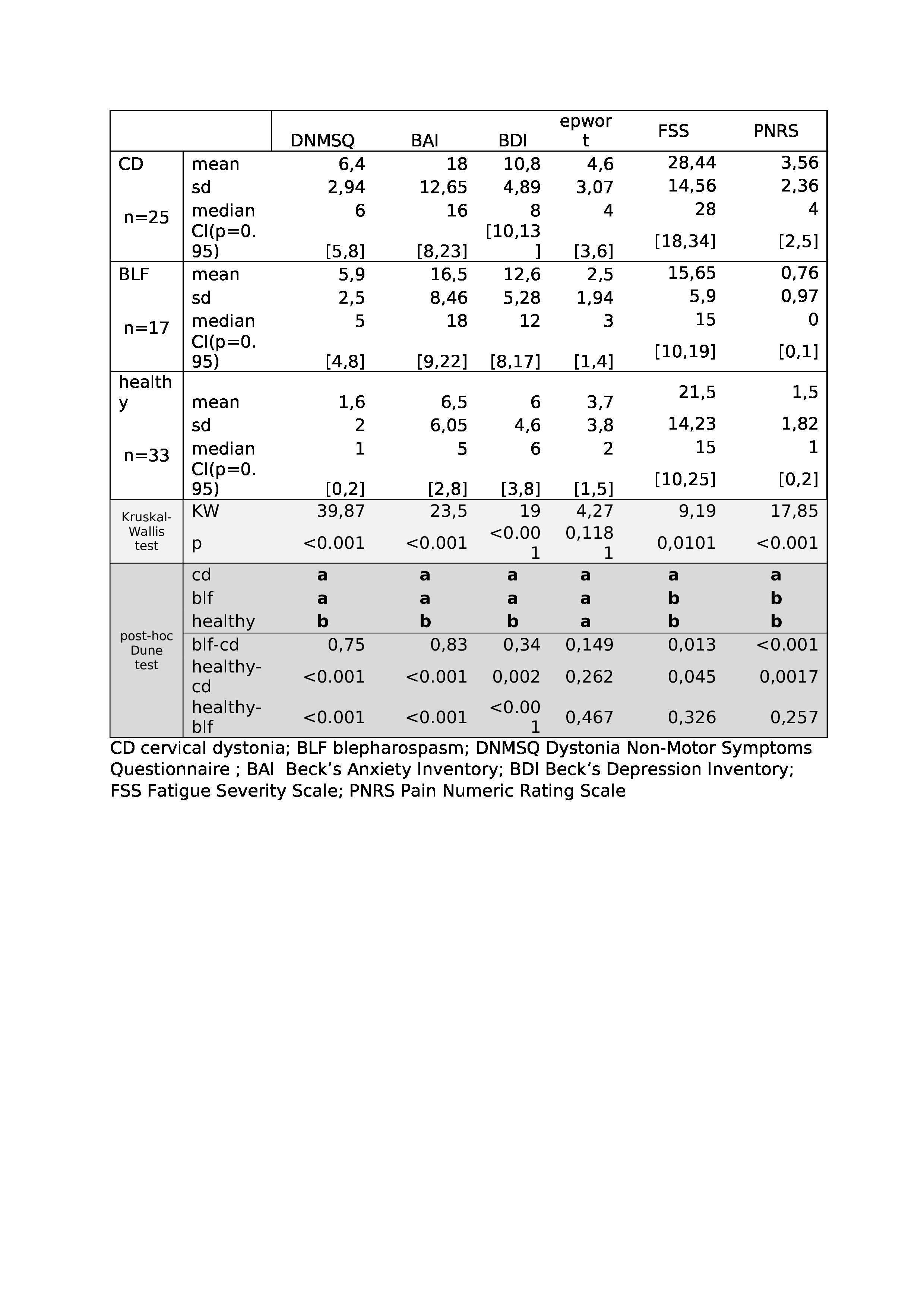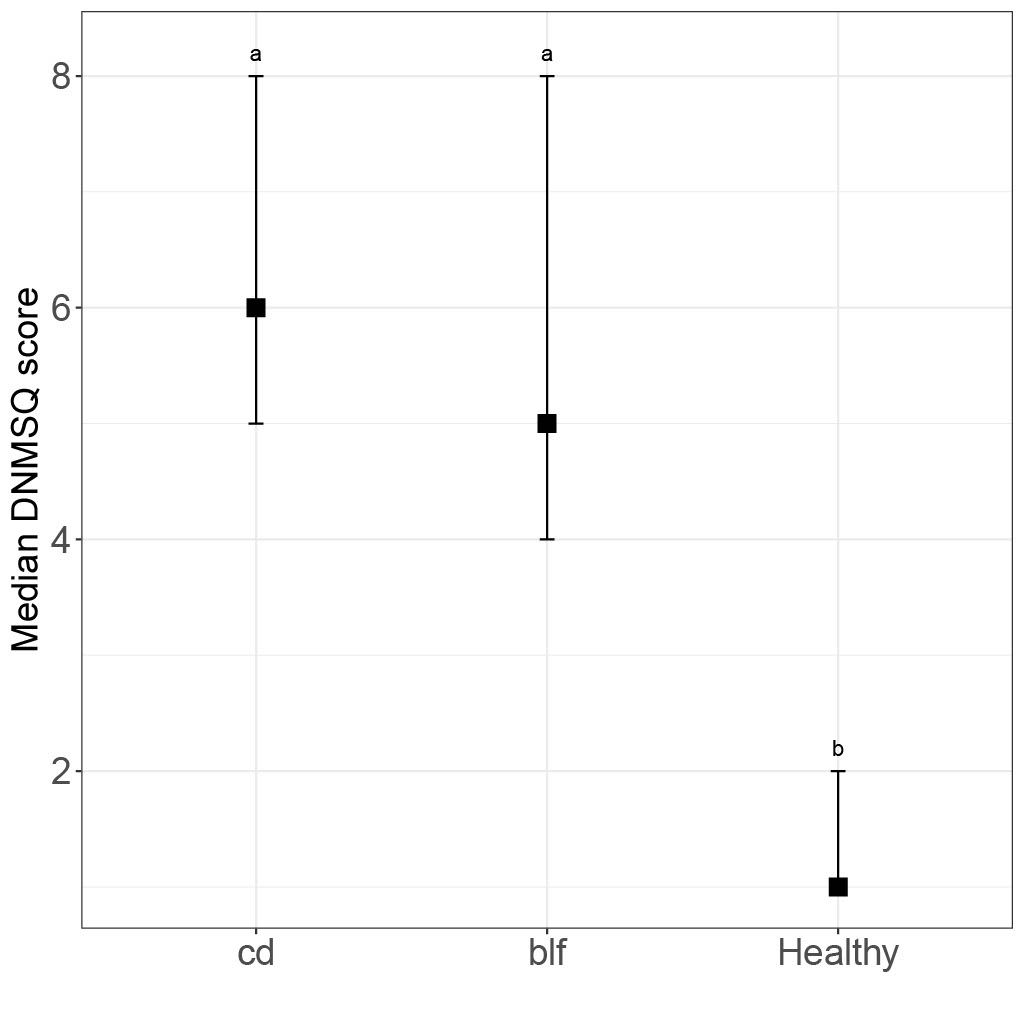Category: Dystonia: Clinical Trials and Therapy
Objective: To assess the prevalence of non-motor symptoms in untreated de-novo patients with cervical dystonia and blepharospasm.
Background: Adult-onset focal dystonia is a movement disorder characterized by involuntary twisting movements and abnormal postures affecting one part of the body with associated different non-motor symptoms (NMS) [1,2]. The NMS occur in patients with dystonia in variable frequency depending on assessment methodology, demographic factors, comorbidities, and current treatment [2-4].
Method: We performed a cross-sectional study to evaluate the frequency of NMS in untreated de-novo patients with CD (n=25) and BLF (n=17) and age-matched healthy controls (n=33). We assessed the prevalence of NMS using recently validated the Dystonia Non-Motor Symptoms Questionnaire (DNMSQuest) [5], Beck’s Depression Inventory (BDI), Beck’s Anxiety Inventory (BAI), Pain Numeric Rating Scale (PNRS), Fatigue Severity Scale (FSS), and Epworth sleepiness scale.
Results: The median total NMS score in CD patients was 6 (CI (p=0.95) [5,8]) and in BLF patients was 5 (CI (p=0.95) [4,8]) for BLF (p=0.75), significantly higher than in healthy controls with median 1 (CI (p=0.95) [4,8]) (p<0.001) (Table 1, Fig. 1). All patients in CD and BLF groups had at least one NMS, while 56% of CD patients and 58% of BLF patients had 5 or more. Evaluation of the psychiatric symptoms showed significantly higher BAI scores in both patients groups (median 16 (CI (p=0.95) [8,23] for CD, median 18 (CI (p=0.95) [9,22] for BLF) compared to healthy controls (median 5 (CI (p=0.95) [2,8]), (p<0.001), and significantly higher BDI scores in both patients groups (median 8 (CI (p=0.95) [10,13] for CD, median 12 (CI (p=0.95) [8,17] for BLF) compared to healthy controls 6 (CI (p=0.95) [3,8]), (p=0.002; p<0.001; respectively). There were no significant difference in FSS and Epworth sleepiness scale between groups. The median PNRS score in CD patients was 4 (CI (p=0.95) [2,5]), significantly higher than in BLF patients with median 0 (CI (p=0.95) [0,1]) p<0.001, and in healthy controls with median 1 (CI (p=0.95) [0,2]) p=0.001. (Table 1). The total number of NMS did not correlate with motor symptoms and demographic data in CD and BLF patients.
Conclusion: The prevalence of NMS in patients with untreated de-novo CD and BLF is higher than in healthy controls with occurrence independent of demographic features and motor symptoms.
References: 1. Albanese A, et al. Phenomenology and classification of dystonia: a consensus update. Mov Disord 2013; 28:863-873.
2. Smit M, et al. The frequency and self-perceived impact of daily life of motor and non-motor symptoms in cervical dystonia. Mov Disord Clin Pract 2017; 4(5):750-754.
3. Klingelhoefer L, et al. Emotional well-being and pain could be a greater determinant of quality of life compared to motor severity in cervical dystonia. J Neural Transmission 2021; 128:305-314.
4. Ferrazzano G, et al. Motor and non-motor symptoms in blepharospasm: clinical and pathophysiological implications. J Neurol 2019; 266(11):2780-2785.
5. Klinglehoefer L, et al. Validation of a self-completed Dystonia Non-Motor Symptoms Questionnaire. Annals of Clinical and Translational Neurology 2019; 6(10):2054-2065.
To cite this abstract in AMA style:
P. Bago Rožanković, S. Lasić. Non-motor symptoms in de-novo adult-onset focal dystonia [abstract]. Mov Disord. 2022; 37 (suppl 2). https://www.mdsabstracts.org/abstract/non-motor-symptoms-in-de-novo-adult-onset-focal-dystonia/. Accessed January 1, 2026.« Back to 2022 International Congress
MDS Abstracts - https://www.mdsabstracts.org/abstract/non-motor-symptoms-in-de-novo-adult-onset-focal-dystonia/


